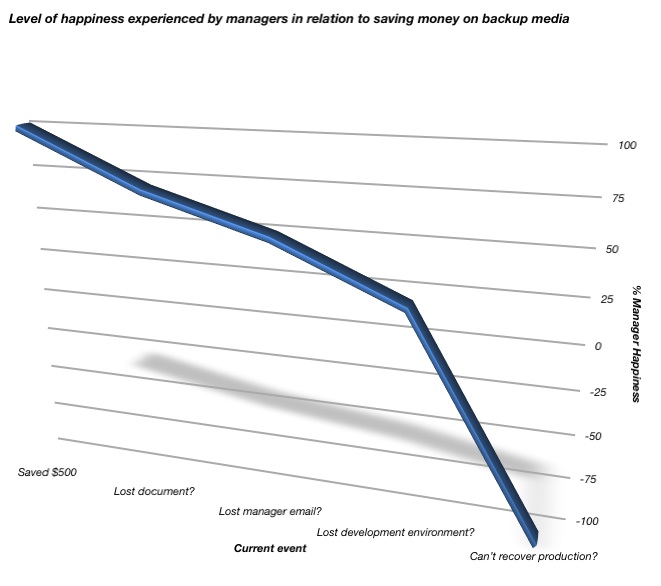There is a profoundly important backup adage that should be front and centre in the mind of any backup administrator, operator, manager, etc. This is:
It is always better to backup a little more than not quite enough.
This isn’t an invitation to wildly waste backup capacity on useless copies that can never be recovered from – or needlessly generate unnecessary backups. However, it should serve as a constant reminder that if you keep shaving important stuff out of your backups, you’ll eventually suffer a Titanic issue.
Now, people at this point often tell me either that (a) they’re being told to reduce the amount of data being backed up or (b) it makes their manager happy to be able to report less OpEx budget required or (c) some combination of the two, or (d) they’re reluctant to ask for additional budget for storage media.
The best way to counter these oppressive and dangerous memes is to draw up a graph of how happy your manager(s) will be over saving a few hundred dollars here and there on media versus potential recovery issues. To get you started, I’ve drawn up one which covers a lot of sites I’ve encountered over the years:
 You see, it’s easy to be happy about saving a few dollars here and there on backup media in the here and now, when your backups are running and you don’t need to recover.
You see, it’s easy to be happy about saving a few dollars here and there on backup media in the here and now, when your backups are running and you don’t need to recover.
However, as soon as the need for a recovery starts to creep in, previous happiness over saving a few hundred dollars rapidly evaporates in direct proportion to the level of the data loss. There might be minimal issues to a single lost document or email, but past that things start to get rather hairy. In fact, it’s very easy to switch from 100% management happiness to 100% management disgruntlement within the space of 24 hours in extreme situations.
You, as a backup administrator, may already be convinced of this. (I would hope you are.) Sometimes though, other staff or managers may need reminding that they too may be judged by more senior management on recoverability of systems under their supervision, so this graph equally applies to them. That continues right up the chain, further reinforcing the fact that backups are an activity which belong to the entire company, not just IT, and therefore they are a financial concern that need to be budgeted for by the entire company.